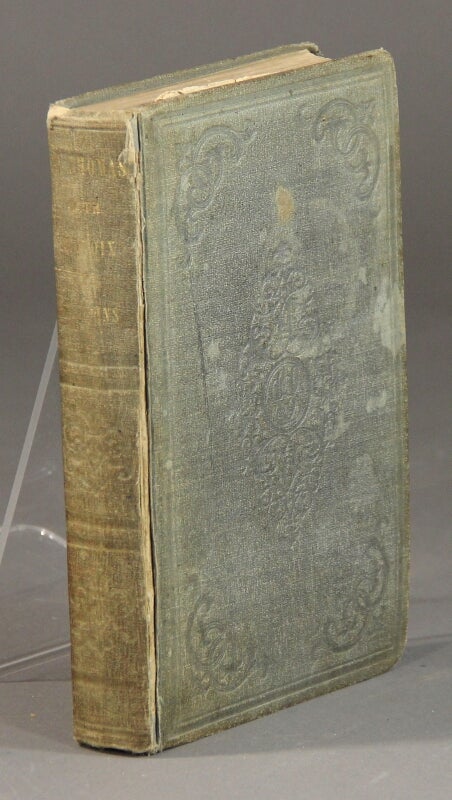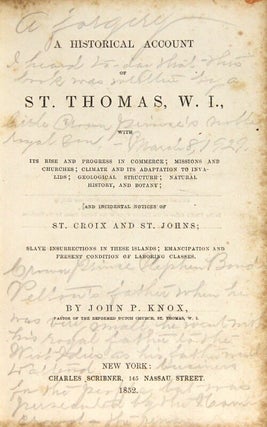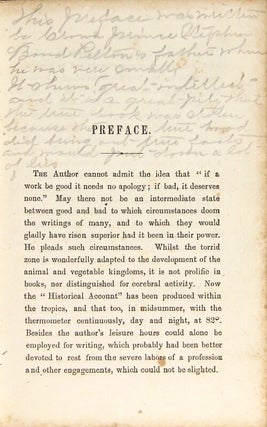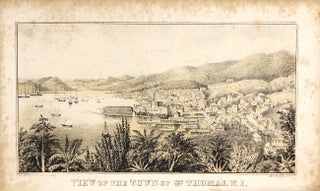Annotations by a conspiracy theorist?
A historical account of St. Thomas, W.I., with its rise and progress in commerce; missions and churches; climate and its adaption to invalids; geological structure; natural history, and botany; and incidental notices of St. Croix and St. Johns; slave insurrections in these islands; emancipation and present condition of laboring classes
New York: Charles Scribner, 145 Nassau Street, 1852. 12mo, pp. xii, [1], 14-271, [1]; tinted lithograph frontispiece of Charlotte Amalie, folding map of the island by H. B. Hornbeck, M.D. in Danish; original brown blindstamped cloth, gilt-lettered spine; cloth cracked along the upper joint, spine a bit dull, one gathering extended, and the map miscreased; all else good and sound. This copy with a whacky reader's extensive annotations on the preliminaries and also a number of pages within. Starting on the title page, in pencil: "A forgery. I heard today that this book was written by a little crown prince's noble royal son, March 8, 1929. Crown prince Stephen Bond Pelton's father when he was very small he went with his father to the West Indies as his father wished to attend business for the people but was persecuted by the [?] crowd - the rena[gades]. [On the verso of title:] "Later after they left and he became a crown lawyer in Nova Scotia - the book was stolen by the renagades that had gone to Farlings [?] Cape to hide away as they had killed so many valuable people in Nova Scotia. They are now in Yarmouth, Nova Scotia and mean to set up slave business but the law had put a stop to their evil work. They want to have a lot of babies to make slaves of them to make money. They are not ashamed of their evil work. The royal people cannot earn money and work so hard to give eye-sight to their evil babies, for them to be [?] and kill good people. [On the first page of preface:] "This preface was written by Crown Prince Stephen Bond Pelton's father when he was very small. It shows great intellect - and it is a great pity that the true book was stolen because the true book did bring out true facts and would just [?] a lot of lies." Another 15 lines at the end of the preface note that Pelton's son is in Yarmouth, that his father "is here in D-mark, and that his royal noble grandfather wrote this book before he was sixteen years old, and that when they were "in the West Indian Islands they were persecuted by the renagades, that hard oathes to behave themselves - they were sent there to work on their crimes." And at the top of Chapter One: "The Historical Society of the World fines the writers of books that are not written truthful - this book is not covered - it is out a page of the renagade life ... it was just written by a little crown prince that went to St. Thomas and at his island's wish his noble royal." On p. 64: "Priest wanted to teach the people to be criminals, he led to steal or kill. The priest was a renagade - very ignorant person." On p. 77: It was the old [?] crowd that did all the evil deeds - they are insane people - they did bad. The slaves converted and educated. They wanted them ignorant like themselves," and so on for another 5 pages or so throughout the remainder of the text. The reader/annotator is anonymous, but given the rough English and the reference to "D-Mark" we might assume him to be a Dane. St. Thomas was largely under Danish control until sold to the United States in 1917. The writer, in fact, was not a 16-year-old crown price but rather John P. Knox who "was born in Savannah, Georgia on July 26, 1811. He got his education at Rutgers College and Seminary. From 1837 to 1841, he was pastor of the Reformed Church at Nassau, New Providence (in the Bahamas). For ten years he was a pastor of the Reformed Church on the island of St. Thomas in the West Indies. While at St. Thomas, Knox wrote [this] history of the island and helped promote education. One young boy, Edward Blyden, grew up to become an ambassador for the Republic of Liberia, the first modern state in Africa" (First Presbyterian Church of Newtown). Sabin 38170. Item #57574
Price: $650.00






